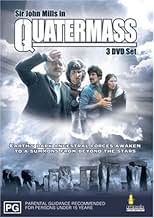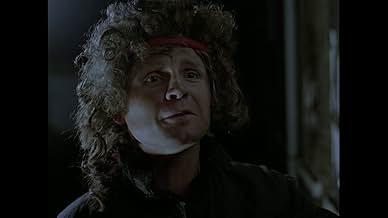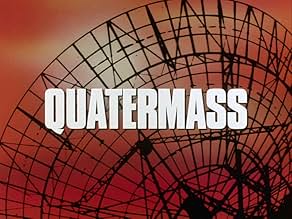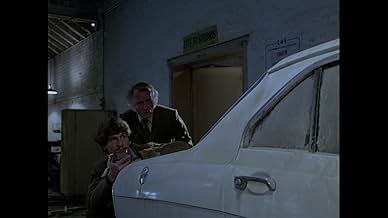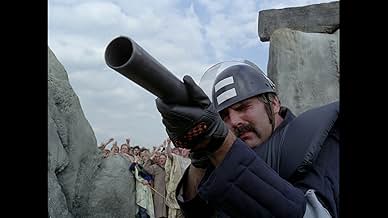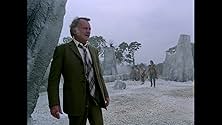Ajouter une intrigue dans votre langueIn the distant future, a now-elderly Bernard Quatermass investigates the disappearance of his granddaughter and a mysterious cult.In the distant future, a now-elderly Bernard Quatermass investigates the disappearance of his granddaughter and a mysterious cult.In the distant future, a now-elderly Bernard Quatermass investigates the disappearance of his granddaughter and a mysterious cult.
Parcourir les épisodes
Avis à la une
The Quatermass Conclusion deals with an alien machine returning to the Earth after five thousand years to 'harvest' and stir-up the glandular secretions of humans which it then uses for it's own ends. Set in a near-future (in the 70s when it was released), the scene is an anarchistic, broken-down and violent vision of Britain, but none of the little touches are over the top enough to be classed as impossible. Prince Charles is on the throne, cars have number plates with 'v' on them and the Metropolitain Police are now privately contracted. Street crime, muggings and overall disorder are all the people know (oh no, it's all coming true!!) When the alien presence is identified as a threat rather than a religious saviour in a chilling Nigel Kneale trademark 'revelation of terror': the body parts in the ashes at Ringstone Round, Quatermass is employed in his quite usual role of leading science against politicians and the military machine to engage the menace. This seems to perk him up a little, when we see him first he is an old man broken down by the anarchy of society, depressed also that his work with the rocket group ended up being misused only for military ends. This is a very bleak piece which would depress viewers if it wasn't so busy chilling and terrifying the hell out if them with trademark Nigel Kneale 'terror revelations' and extremely succinct scientific concepts and valid predictions. Not only that, but it lays claim to having the most chilling and atmospherically terrifying aspect of all of the Quatermass films and serials, the spine-tingling refrain of 'huffity-puffity Ringstone Round'. I always only ever thought there were three Quatermass serials, Xperiment, II and Pit, up until about 4 years ago, when a conversation in a pub about there being another where 'people were being drawn to Stonehenge to be eaten' put me on the trail of this, and the first time I managed to get to see it after this revelation my blood ran cold at that nursery rhyme. I had a shudder just then recalling it.
Nigel Kneale wrote a story here equally as inventive and thought provoking as QUATERMASS AND THE PIT. Perhaps more cerebral and decidedly less horrific, but no less disturbing in its connotations. The concept of an alien technology "harvesting" the world's youth for its own physiological needs is both original and brilliant in its execution. Like its forerunners, originally shown as a mini-series, this being an arguably effective re-edit!
Where the film cannot hold-up to its predecessors unfortunately, is that it was done "on the cheap" and much as I personally respect and admire Sir John Mills' wonderful career (its unassailable highlights being the village idiot in RYANS DAUGHTER and Captain Anson in ICE COLD IN ALEX) for me, he doesn't have the physical presence for the role of Professor Quatermass! Simon MacCorkindale additionally, is a bit on the wussy side for my money. But hey, let's move on to the positives!
The setting of England, moving into a near post-apocalyptic state with anarchy ruling, the Police in the hands of Private ownership is pretty cool for 1978 - we're getting there nicely! Mills portrays the old disillusioned and resigned-to-it-all Quatermass so well. Retired now, all he wants in life is to find his missing grand-daughter. When the first terrifying beam from space sucks up its first victims and destroys a joint Anglo-Russian Space project, he is summoned to assist the Ministry.
Kneale has his knee on the viewer's neck at times as the beam returns for more of the world's youth. Although the budget ran obviously to limited fx, the attack on Wembley Stadium leaves any aware and thinking person with real spinal tap! Again, Kneale resorts to an association with lore and magic and the images of the hippie-esque multitudes as they converge on Stonehenge singing "Huffity Puffity Ringstone Round" are as chilling as any scenes I have ever seen. Kneale reaches right out of the screen here and puts one in an arm-lock. You ain't going nowhere, but WITH them to Ringstone Round!
Quatermass' ultimate understanding of the code and what it all means is literate stuff, his plan to rebuff the alien threat sheer genius. Without giving anything away, the final scene with his granddaughter ranks as one of the most moving and shatteringly emotional scenes in film history. If you can't SEE that, what a shame!
Where the film cannot hold-up to its predecessors unfortunately, is that it was done "on the cheap" and much as I personally respect and admire Sir John Mills' wonderful career (its unassailable highlights being the village idiot in RYANS DAUGHTER and Captain Anson in ICE COLD IN ALEX) for me, he doesn't have the physical presence for the role of Professor Quatermass! Simon MacCorkindale additionally, is a bit on the wussy side for my money. But hey, let's move on to the positives!
The setting of England, moving into a near post-apocalyptic state with anarchy ruling, the Police in the hands of Private ownership is pretty cool for 1978 - we're getting there nicely! Mills portrays the old disillusioned and resigned-to-it-all Quatermass so well. Retired now, all he wants in life is to find his missing grand-daughter. When the first terrifying beam from space sucks up its first victims and destroys a joint Anglo-Russian Space project, he is summoned to assist the Ministry.
Kneale has his knee on the viewer's neck at times as the beam returns for more of the world's youth. Although the budget ran obviously to limited fx, the attack on Wembley Stadium leaves any aware and thinking person with real spinal tap! Again, Kneale resorts to an association with lore and magic and the images of the hippie-esque multitudes as they converge on Stonehenge singing "Huffity Puffity Ringstone Round" are as chilling as any scenes I have ever seen. Kneale reaches right out of the screen here and puts one in an arm-lock. You ain't going nowhere, but WITH them to Ringstone Round!
Quatermass' ultimate understanding of the code and what it all means is literate stuff, his plan to rebuff the alien threat sheer genius. Without giving anything away, the final scene with his granddaughter ranks as one of the most moving and shatteringly emotional scenes in film history. If you can't SEE that, what a shame!
It is the near future. Britain struggles with the collapse of civilisation and violent bands of urban guerrillas rule. Also Earth is being harvested. Ancient sites of gathering all over the globe turn out to be the focal points of a blinding and powerful ray from outer space that leaves a pile of ash where thousands once stood. Various elements of Homo sapiens are essential to an anonymous alien race, and once again the time is, or rather we are, literally, ripe. It falls on the now retired Professor Bernard Quatermass, veteran of weird goings on long before Fox Mulder, to basically save the planet. Again.
The idea of a fourth Quatermass serial was kicked around the BBC for three years before being finally commissioned in 1971, and then later dropped by them as being too expensive. The production was picked up by Euston Films, Thames Television's TV film-making subsidiary (their most famous production at the time being the uncompromising and controversial police drama 'The Sweeney'). Euston increased the budget to £300,000 per episode with the criterion that the final product be produced in two versions: four fifty-minute episodes plus a single, shortened version for theatrical release and overseas markets in order to recoup some of their production costs. This created a writing dilemma for original creator and writer Nigel Kneale who now had to come up with two scripts for the same story. He neither wanted the theatrical release to be an edited version of the series, nor the series to be a padded out version of the film. Both had to work in their own right, and, thanks to Kneale's skill (he was an experienced screenwriter and at one time 'script doctor' for the BBC), they do. Unfortunately with the story having been written in 1972 and reflecting the political and economic concerns of that time, by the time it reached the screens in 1979, with it's new-age hippy type characters, it was already out of date (though it is still superior to the recent and dreadful '28 Days Later').
Euston also wanted a big name to play the lead, hence Sir John Mills, who is badly miscast and clearly looks as uneasy as he reportedly was with the role. Gone is the bombastic, resourceful yet flawed character played in the '50s BBC serials by Reginald Tate and brilliantly by Andre Morell, and later more famously by Andrew Keir in Hammer's 1967 'Quatermass and the Pit' (American actor Brian Donlevy had played the role in the first two Hammer Films but Kneale so hated him in the role he withheld permission to make a third Quatermass film for ten years). Here Mills plays him as a semi-senile, despairing, doddering tired old man. He is as much Quatermass as Peter Cushing was Dr. Who, but he fulfilled the need of the 'big name' at the time, being not only an already established British film dignitary and household name, but also then still familiar to TV audiences as having recently appeared in the popular 'Zoo Gang'. But it is hard to believe this is meant to be the same Quatermass we have seen in previous incarnations.
The plusses though are in the production values. At that time most British TV drama series tended to be controlled environment, studio bound affairs with the odd bit of grainy location footage (a la 'Dr. Who', 'Doomwatch' etc.) but 'Quatermass' was, strikingly for the time, shot entirely on location on 35mm Panavision, with great expense being laid out particularly on Joe Kapp's radar facility and home. It was also intended that Stonehenge would be one of the main locations. Permission to use it was however withdrawn by the British Tourist Board because it had become very popular with tourists and they didn't want anyone, or anything, even by inference (in the script several thousand people get fried simply by gathering there, so I suppose not a good selling point from their point of view), jeopardising their little earner.
Sci-Fi/Fantasy film and TV buffs will enjoy early appearances by Simon MacCorkindale, later of the short lived series 'Manimal'; Brian Croucher (the second 'Travis' in 'Blake's 7'); Declan Mullholland (the original, later CGI'd out, actor who played 'Jabba the Hutt' in 'Star Wars') as a TV Studio guard; David Yip, who would be Indie's ill-fated accomplice in the 'Club Obi-Wan' in the opening sequence of 'Indiana Jones and the Temple of Doom'; and, talking of Indie, a major role played by Margaret Tyzack, who would later become the young Indie's long-suffering Oxford tutor in 'The Young Indiana Jones Chronicles'. Also featured in an early role is Brenda Fricker, later to win an Oscar for Best Supporting Actress in 'My Left Foot'. Executive Producer Verity Lambert was already well known to fans of this genre for her involvement with 'Dr. Who' and 'The Avengers'.
If you are a Quatermass fan, a fan of British Sci-Fi, or even a budding screenwriter wanting to pick up a few tips, then this is an essential addition to your library. The set is nicely presented and is released to coincide with the 50th anniversary of the first broadcast of 'The Quatermass Experiment' in 1953. The package folds out to an 18" picture of (ironically) Stonehenge. The two discs containing the four episodes, simply called 'Quatermass', feature extensive production notes, animated menus, the opening and closing titles for each episode with each episode having a spectacular cliffhanger ending, making you eager to watch the next, and the hours pass swiftly. The third disc contains the theatrical version, retitled 'The Quatermass Conclusion', and a previously unseen Sci-Fi Channel interview with Nigel Kneale. Also enclosed is a booklet on the Quatermass history.
Overall it is an engrossing watch, but as Nigel Kneale himself says: "It was a product of its time."
The idea of a fourth Quatermass serial was kicked around the BBC for three years before being finally commissioned in 1971, and then later dropped by them as being too expensive. The production was picked up by Euston Films, Thames Television's TV film-making subsidiary (their most famous production at the time being the uncompromising and controversial police drama 'The Sweeney'). Euston increased the budget to £300,000 per episode with the criterion that the final product be produced in two versions: four fifty-minute episodes plus a single, shortened version for theatrical release and overseas markets in order to recoup some of their production costs. This created a writing dilemma for original creator and writer Nigel Kneale who now had to come up with two scripts for the same story. He neither wanted the theatrical release to be an edited version of the series, nor the series to be a padded out version of the film. Both had to work in their own right, and, thanks to Kneale's skill (he was an experienced screenwriter and at one time 'script doctor' for the BBC), they do. Unfortunately with the story having been written in 1972 and reflecting the political and economic concerns of that time, by the time it reached the screens in 1979, with it's new-age hippy type characters, it was already out of date (though it is still superior to the recent and dreadful '28 Days Later').
Euston also wanted a big name to play the lead, hence Sir John Mills, who is badly miscast and clearly looks as uneasy as he reportedly was with the role. Gone is the bombastic, resourceful yet flawed character played in the '50s BBC serials by Reginald Tate and brilliantly by Andre Morell, and later more famously by Andrew Keir in Hammer's 1967 'Quatermass and the Pit' (American actor Brian Donlevy had played the role in the first two Hammer Films but Kneale so hated him in the role he withheld permission to make a third Quatermass film for ten years). Here Mills plays him as a semi-senile, despairing, doddering tired old man. He is as much Quatermass as Peter Cushing was Dr. Who, but he fulfilled the need of the 'big name' at the time, being not only an already established British film dignitary and household name, but also then still familiar to TV audiences as having recently appeared in the popular 'Zoo Gang'. But it is hard to believe this is meant to be the same Quatermass we have seen in previous incarnations.
The plusses though are in the production values. At that time most British TV drama series tended to be controlled environment, studio bound affairs with the odd bit of grainy location footage (a la 'Dr. Who', 'Doomwatch' etc.) but 'Quatermass' was, strikingly for the time, shot entirely on location on 35mm Panavision, with great expense being laid out particularly on Joe Kapp's radar facility and home. It was also intended that Stonehenge would be one of the main locations. Permission to use it was however withdrawn by the British Tourist Board because it had become very popular with tourists and they didn't want anyone, or anything, even by inference (in the script several thousand people get fried simply by gathering there, so I suppose not a good selling point from their point of view), jeopardising their little earner.
Sci-Fi/Fantasy film and TV buffs will enjoy early appearances by Simon MacCorkindale, later of the short lived series 'Manimal'; Brian Croucher (the second 'Travis' in 'Blake's 7'); Declan Mullholland (the original, later CGI'd out, actor who played 'Jabba the Hutt' in 'Star Wars') as a TV Studio guard; David Yip, who would be Indie's ill-fated accomplice in the 'Club Obi-Wan' in the opening sequence of 'Indiana Jones and the Temple of Doom'; and, talking of Indie, a major role played by Margaret Tyzack, who would later become the young Indie's long-suffering Oxford tutor in 'The Young Indiana Jones Chronicles'. Also featured in an early role is Brenda Fricker, later to win an Oscar for Best Supporting Actress in 'My Left Foot'. Executive Producer Verity Lambert was already well known to fans of this genre for her involvement with 'Dr. Who' and 'The Avengers'.
If you are a Quatermass fan, a fan of British Sci-Fi, or even a budding screenwriter wanting to pick up a few tips, then this is an essential addition to your library. The set is nicely presented and is released to coincide with the 50th anniversary of the first broadcast of 'The Quatermass Experiment' in 1953. The package folds out to an 18" picture of (ironically) Stonehenge. The two discs containing the four episodes, simply called 'Quatermass', feature extensive production notes, animated menus, the opening and closing titles for each episode with each episode having a spectacular cliffhanger ending, making you eager to watch the next, and the hours pass swiftly. The third disc contains the theatrical version, retitled 'The Quatermass Conclusion', and a previously unseen Sci-Fi Channel interview with Nigel Kneale. Also enclosed is a booklet on the Quatermass history.
Overall it is an engrossing watch, but as Nigel Kneale himself says: "It was a product of its time."
I recently watched the complete four-hour version of Nigel Kneale's British miniseries "Quatermass." I had seen an edited movie version called "The Quatermass Conclusion" some years earlier. The verdict: The miniseries is superior. It expands on several subplots (of course) and offers richer characterizations. John Mills makes an excellent Quatermass--somewhat befuddled at the outset, but strong and clear of mind when the survival of the world is at stake. Granted, the production is not as polished as the movie version of "Quatermass and the Pit" (the music, in particular, sounds like it costs a couple of hundred bucks). But the ideas are intriguing and that darn nursery rhyme about Ringstone Round is still running around my brain. Kneale wrote a novelization of the miniseries that clarifies a few vague points.
I remember seeing this broadcast. It was made by Euston Films so I was expecting th usual "Sweeney" type over-grain in the picture (1970's high speed 16mm), but instead it had the full gorgeous look of a motion picture, having been shot in 35mm with full motion picture negative (whereas most American productions were shot on 35mm television stock). The special effects where not all that good where the space shots were concerned - even by 1970's standards (to see good examples of these effects look at Space 1999 (1976 - 1978) whose Director of Effects, Brian Johnson, went on to win an Oscar just a couple of years later - for Alien). But the idea that a beam would come through space and consume vast number of people and turn them into a diaphanous web was effectively executed. It would be nice to see it again in its full version - perhaps the BBC could show it without breaks in two parts. Also it was an early appearance for Simon McQuorkindale (Manimal!).
Le saviez-vous
- AnecdotesStarted life in 1973 as a BBC series called "Quatermass IV". It had been commissioned by Head of Drama Ronald Marsh, and according to Nigel Kneale, the intended producer was Joe Waters. Some model test sequences of the space station were shot, but eventually, the project was abandoned by the BBC. ITV then picked it up a few years later and produced it in association with Euston Films.
- Versions alternativesThis has been made available in the United States in two versions. It was first released edited down to a 105 minute feature film under the title The Quatermass Conclusion (1979). In 2003 the complete program was released on home video under the title "Quatermass" with a listed running time of 240 minutes.
- ConnexionsEdited into The Quatermass Conclusion (1979)
Meilleurs choix
Connectez-vous pour évaluer et suivre la liste de favoris afin de recevoir des recommandations personnalisées
- How many seasons does Quatermass have?Alimenté par Alexa
Détails
Contribuer à cette page
Suggérer une modification ou ajouter du contenu manquant

